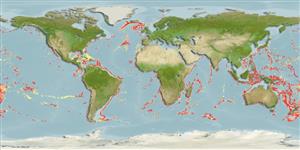Teleostei (teleosts) >
Ophidiiformes (Cusk eels) >
Ophidiidae (Cusk-eels) > Neobythitinae
Etymology: Lamprogrammus: Greek, lampros = light + Greek, gramma = letter, signal (Ref. 45335).
Eponymy: H Brunswig was first officer aboard the research vessel ‘Valdivia’, the vessel employed on the first German expedition to explore deep seas. [...] (Ref. 128868), visit book page.
Environment: milieu / climate zone / depth range / distribution range
Ecology
Marine; benthopelagic; depth range 800 - 1600 m (Ref. 34024). Deep-water
Circumtropical except the eastern Pacific.
Size / Weight / Age
Maturity: Lm ? range ? - ? cm
Max length : 90.0 cm TL male/unsexed; (Ref. 3686)
Benthic (Ref. 58302) or benthopelagic at bathyal depth (Ref. 56809). Rare species (Ref. 34024). Reproductive strategy possibly similar to other members of this family featuring oviparity, with oval pelagic eggs floating in a gelatinous mass (Ref. 205).
Life cycle and mating behavior
Maturity | Reproduction | Spawning | Eggs | Fecundity | Larvae
Nielsen, J.G., D.M. Cohen, D.F. Markle and C.R. Robins, 1999. Ophidiiform fishes of the world (Order Ophidiiformes). An annotated and illustrated catalogue of pearlfishes, cusk-eels, brotulas and other ophidiiform fishes known to date. FAO Fish. Synop. 125(18):178p. Rome: FAO. (Ref. 34024)
IUCN Red List Status (Ref. 130435: Version 2024-1)
Threat to humans
Harmless
Human uses
Fisheries: of no interest
Tools
Special reports
Download XML
Internet sources
Estimates based on models
Preferred temperature (Ref.
123201): 3 - 6.7, mean 4.6 °C (based on 817 cells).
Phylogenetic diversity index (Ref.
82804): PD
50 = 0.5312 [Uniqueness, from 0.5 = low to 2.0 = high].
Bayesian length-weight: a=0.00110 (0.00040 - 0.00297), b=3.08 (2.85 - 3.31), in cm total length, based on LWR estimates for this (Sub)family-body shape (Ref.
93245).
Trophic level (Ref.
69278): 3.8 ±0.6 se; based on size and trophs of closest relatives
Resilience (Ref.
120179): Low, minimum population doubling time 4.5 - 14 years (Preliminary K or Fecundity.).
Fishing Vulnerability (Ref.
59153): High vulnerability (56 of 100).
Nutrients (Ref.
124155): Calcium = 13.2 [7.4, 28.1] mg/100g; Iron = 0.291 [0.147, 0.565] mg/100g; Protein = 15.2 [12.8, 17.7] %; Omega3 = 0.281 [0.137, 0.581] g/100g; Selenium = 32.3 [12.6, 80.7] μg/100g; VitaminA = 10.2 [2.1, 48.1] μg/100g; Zinc = 0.373 [0.242, 0.582] mg/100g (wet weight);
